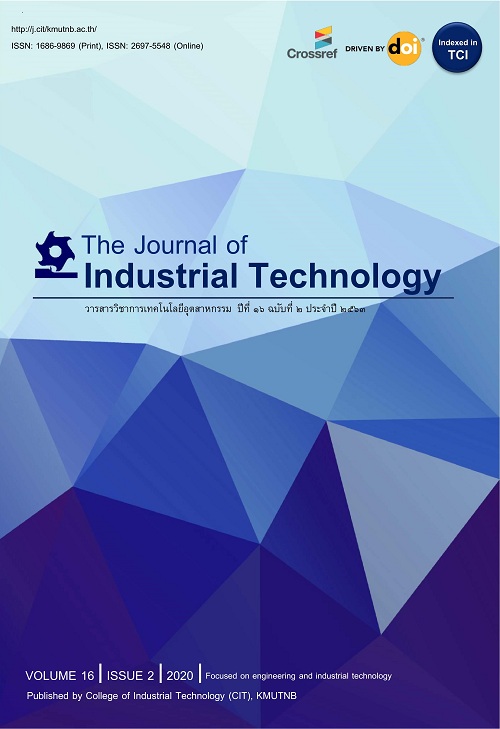Response Surface Optimization on Flexural Properties of Wood-Plastic Composites for Structure Materials Exposed to High Moisture Content
Abstract
การออกแบบการทดลองแบบผสมถูกใช้ในการกำหนดเพื่อหาสูตรการผสมที่เหมาะสมของวัสดุเชิงประกอบพลาสติกและไม้ (Wood-Plastic Composites; WPCs) โดยมีปัจจัยในการออกแบบการทดลอง คือ พอลิโพรพีลีนรีไซเคิล ขี้เลื่อยไม้ยางพารา นาโนเคลย์ สารควบคู่ และสารหล่อลื่น ตามลำดับ ตัวอย่างการทดสอบถูกเตรียมด้วยกระบวนการอัดรีดเกลียวหนอนคู่ (Extrusion) และการอัดร้อน (Hot-Press) ผลการทดลองถูกวิเคราะห์ด้วยการวิเคราะห์ความแปรปรวน (ANOVA) และหาค่าสูตรผสมที่เหมาะสมโดยวิธีพื้นผิวตอบสนอง (Response Surface Methodology; RSM) จากผลการทดลอง พบว่า ปัจจัยทั้งหมดในการออกแบบมีผลกระทบต่อสมบัติแรงดัดและการดูดซับน้ำอย่างมีนัยสำคัญ (p < 0.05) กล่าวคือ สมบัติแรงดัดจะมีค่าลดลงเมื่อชิ้นงานตัวอย่างผ่านการแช่น้ำระยะเวลา 1 และ 3 เดือน นอกจากนี้ การเพิ่มขึ้นของนาโนเคลย์ส่งผลให้สมบัติแรงดัดเพิ่มขึ้น แต่สมบัติการดูดซับน้ำลดลง ตามลำดับ ซึ่งสูตรการผสมที่เหมาะสมสำหรับการทดลองนี้ คือ พอลิโพพีลีน รีไซเคิล (50.7 wt%) ขี้เลื่อยไม้ยางพารา (36.1 wt%) นาโนเคลย์ (9.2 wt%) สารควบคู่ (3.0 wt%) และสารหล่อลื่น (1.0 wt%) ที่ความพึงพอใจ 0.936 แสดงว่า ตัวแบบการทดลองสามารถทำนายการตอบสนองได้ในระดับความพึงพอใจถึง 93.60% ซึ่งมีค่าที่สูง ตามลำดับ
Mixture design was used to determine the optimal formulation of wood-plastic composites (WPCs). Factors were recycled polypropylene (rPP), rubberwood sawdust (RWS), nanoclay (NC), maleic anhydride grafted polypropylene (MAPP), and lubricant (WAX). The specimens were prepared from an extrusion and compression molding machine. The experimental results were evaluated using analysis of variance (ANOVA) and optimized using response surface methodology (RSM). The results showed that all of the factors significantly (p < 0.05) affected the flexural and water absorption properties of WPCs. The flexural properties (MOR and MOE) decreased after immersion in water for periods of 1 and 3 months. The increase of the NC content increased the flexural properties but decreased the water absorption. The optimal formulation for overall properties had consisted of 50.7 wt% rPP, 36.1 wt% RWS, 9.2 wt% NC, 3.0 wt% MAPP, and 1.0 wt% WAX. The desirability of the overall properties was 0.936, suggesting that the model was able to predict the response to an adequate extent of 93.60%.
Keywords
[1] C. Srivabut, T. Ratanawilai, and S. Hiziroglie, Statistical modeling and response surface optimization on natural weathering of wood-plastic composites with calcium carbonate filler, Journal of Material Cycles and Waste Management, 2021, 23(4), 1503-1517.
[2] T. Ratanawilai, P. Lekanukit, and S. Urapantamas, Effect of rubberwood and palm oil content on the properties of wood–polyvinyl chloride composites, Journal of Thermoplastic Composites Material, 2014, 27(6), 719-730.
[3] S. Khamtree, T. Ratanawilai, and S. Ratanawilai, The effect of alkaline-silane treatment of rubberwood flour for water absorption and mechanical properties of plastic composites, Journal of Thermoplastic Composites Material, 2020, 33(5), 599-613.
[4] Z. H. Xu and Z. N. Kong, Mechanical and thermal properties of short-coir-fiberreinforced natural rubber/polyethylene composites, Mechanics of Composite Materials, 2014, 50(3), 353-358.
[5] C. Homkhiew, T. Ratanawilai, and W. Thongruang, The optimal formulation of recycled polypropylene/rubberwood flour composites from experiments with mixture design, Composites Part B: Engineering, 2014, 56, 350-357.
[6] C. Srivabut, T. Ratanawilai, and S. Hiziroglie, Response surface optimization and statistical analysis of composites made from calcium carbonate filler-added recycled polypropylene and rubberwood fiber, Journal of Thermoplastic Composites Material, Article in press, 22 November 2019.
[7] R.Z. Huang, C.T. Mei, X.W. Xu, T. Karki, S. Lee, and Q.L. Wu, Effect of hybrid talc-basalt fillers in the shell layer on thermal and mechanical performance of co-Extruded wood plastic composites. Materials, 2015, 8, 8510-8523.
[8] H. Anuar and A. Zuraida, Improvement in mechanical properties of reinforced thermoplastic elastomer composite with kenaf bast fibre, Composites Part B: Engineering, 2011, 42(3), 462-465.
[9] A. Ashori and S. Sheshmani, Hybrid composites made from recycled materials: Moisture absorption and thickness swelling behavior, Bioresource Technology, 2010, 101(12), 4717-4720.
[10] C. Homkhiew, T. Ratanawilai and W. Thongruang, Effects of natural weathering on the properties of recycled polypropylene composites reinforced with rubberwood flour, Industrial Crops and Products, 2014, 56, 52–59.
[11] A. Zolfaghari, A.H. Behravesh and P. Shahi, Comparison of mechanical properties of wood–plastic composites reinforced with continuous and noncontinuous glass fibers, Journal of Thermoplastic Composites Material, 2015, 28(6), 791-805.
[12] D. Akesson, T. Fuchs, M. Stoss, A. Root, E. Stanvall, and M. Skrifvars, Recycling of wood fiber-reinforced HDPE by multiple reprocessing, Journal of Applied Polymer Science, 2016, 133(35), 43877.
[13] C. Srivabut, T. Ratanawilai, and S. Hiziroglie, Effect of nanoclay, talcum, and calcium carbonate as filler on properties of composites manufactured from recycled polypropylene and rubberwood fiber, Construction and Building Materials, 2018, 162, 450-458.
[14] S. Tamrakar and R.A. Lopez-Anido, Water absorption of wood polypropylene composite sheet piles and its influence on mechanical properties, Construction and Building Materials, 2011, 25(10), 3977-3988.
[15] H. Essabir, R. Boujmal, M.O. Bensalah, D. Rodrigue, R. Bouhfid, and A.E. Qaiss, Mechanical and thermal properties of hybrid composites: oil-palm fiber/clay reinforced high density polyethylene, Mechanics of Materials, 2016, 98, 36-43.
[16] C. Homkhiew, and T. Ratanawilai, Optimal proportions of composites from polypropylene and rubberwood flour after water immersion using experimental design, KKU Research Journal, 2014, 19, 780-793. (in Thai)
[17] E.O. Olakanmi, E.A. Ogunesan, E. Vunain, R.A. Lafia-Araga, M. Doyoyo, and R. Meijboom, Mechanism of fiber/matrix bond and properties of wood polymer composites produced from alkaline-treated daniella oliveri wood flour, Journal of Polymer Composites, 2016, 37(9), 2657-2672.
[18] P. Y. Kuo, S. Y. Wang, J. H. Chen, H. C. Hsueh, and M. J. Tsai, Effects of material compositions on the mechanical properties of wood–plastic composites manufactured by injection molding, Material & Design, 2009, 30(9), 3489-3496.
[19] T. Ratanawilai, and K. Taneerat, Alternative polymeric matrices for wood-plastic composites: Effects on mechanical properties and resistance to natural weathering, Construction and Building Materials, 2018, 172, 349-357.
DOI: 10.14416/j.ind.tech.2022.02.001
Refbacks
- There are currently no refbacks.






